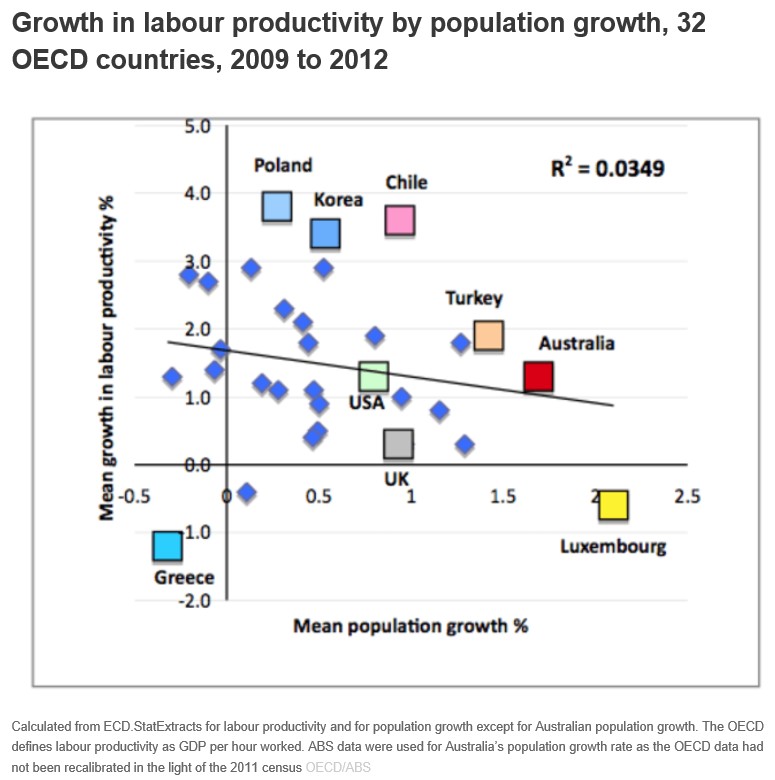In 2003 I arrived at the Australian Treasury to begin my career as an economist.
Upon arriving at Treasury, I was introduced to the “three P’s” framework by then Treasury Secretary, Ken Henry.
According to this framework, we were told that Australia must: 1) boost productivity; 2) raise workforce participation; and 3) increase the population via skilled migration, if the nation was to continue to enjoy rising living standards.
Personally, I do not subscribe to the three P’s framework, and would prefer that it was pared back to the “Two Ps” of productivity and participation.
Of the three P’s, boosting productivity is by far the most important driver of rising living standards over the long-term, since it allows more goods/services to be produced (consumed) from less effort.
Raising labour force participation can also raise living standards. However, working more hours (increasing participation) can mean that less time is available for other pursuits, such as relaxing or meeting-up with friends. So while working more will, other things equal, raise incomes and GDP, it can also take away from the other pleasures in life, reducing its benefit.
By contrast, population growth’s impact on living standards is highly questionable. While it certainly does raise headline GDP (more inputs equals more outputs), there are significant doubts over whether it raises per capita GDP, while also placing greater pressure on the environment, pre-existing infrastructure and housing, and Australia’s fixed endowment of mineral resources (see here for a detailed run-down of the issues).
Indeed, Katharine Betts, an Adjunct Associate Professor of Sociology at Swinburne University of Technology, has found that that data from 32 OECD countries show no statistically significant association between productivity and population growth:

Dr Betts has also called on Treasury to reduce the trifecta of the three Ps to a duo of productivity and participation:
…the deep shortcomings of GDP as a measure of well-being are now all too well known; for example the misery that commuters experience stuck in traffic shows up as a positive for GDP (more petrol consumed, more costly wear and tear on vehicles), and the GDP takes no count at all of the drag that the congestion imposes on productivity. In contrast the State of Australian Cities report predicts traffic congestion in the major cities will cost Australians A$20.4 billion a year by 2020 and stories of its ill effects on productivity are commonplace…
High immigration may have no effect on productivity, as the figure above shows, or as the Australian experience suggests, may reduce it. And it can be irrelevant to participation.
Now it seems that even Ken Henry, the architect behind the “three P’s” framework, is having second thoughts, penning the following today warning about Australia’s excessively high population (immigration) growth, via The Australian [my emphasis]:
Here are a few things most Australians know. They know that the budget is unsustainable and that a government that refuses to address the quality of the tax system is not going to fix the problem.
They know our population is growing at a rate that exceeds the capacity of traditional models of planning, building and pricing access to the nation’s infrastructure and housing. They know that productivity growth will not be boosted significantly without a substantial contribution from economic infrastructure and without further investments in education.
They know that climate change is real and that Australia risks committing itself to a national balance sheet of stranded assets because of its incapacity to sustain rational policy responses.
Last July, RBA Governor Glenn Stevens took a veiled swipe at Australia’s high immigration program, endorsing a shift away from quantitative measures to boost growth, such as high immigration, to qualitative measures that improve productivity and living standards on a per capita basis.
Then in August, the National Reform Summit released its final statement, which included an entire section on the need to boost productivity and participation, but excluded any mention of the need for population growth (immigration) in order to improve living standards.
When viewed alongside Dr Henry’s admission above, there seems to be a belated acknowledgement from Australia’s leaders and policy makers that high immigration is not an economic bonanza, and is in fact just as likely to damage the nation’s productivity and living standards.
The next step is for the Australian Treasury to dump the Three P’s framework in favour of the Two Ps, and for our politicians to follow suit and abandon their “Big Australia” agenda.

